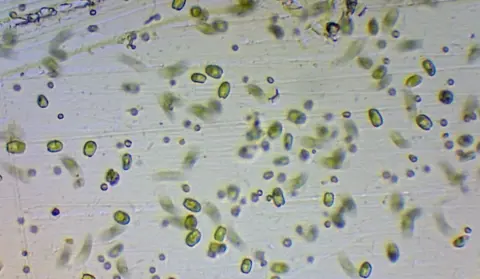🌿 Tisochrysis lutea
- Dion Tomaras
- May 7, 2025
- 3 min read

The Golden Microalga Powering Aquaculture and Beyond
Tisochrysis lutea, commonly referred to as T-iso, is a golden-brown microalga that has garnered significant attention in aquaculture and biotechnology sectors. Renowned for its exceptional nutritional profile and adaptability, T-iso plays a pivotal role in marine hatcheries and holds promise for various industrial applications.
🧬 Taxonomy and Discovery
Originally misclassified as Isochrysis affinis galbana (Tahiti isolate), T-iso was redefined as a distinct species in 2013 by Bendif et al., leading to the establishment of the new genus Tisochrysis . The nomenclature reflects its Tahitian origin ("Ti") and its golden hue ("lutea").
Taxonomic Classification:
Phylum: Haptophyta
Class: Coccolithophyceae
Order: Isochrysidales
Family: Isochrysidaceae
Genus: Tisochrysis
Species: Tisochrysis lutea

🌍 Origin and Habitat
T-iso was first isolated from the warm, nutrient-rich lagoons of Tahiti, French Polynesia, during the late 1970s . These tropical waters, characterized by high temperatures (~29°C), salinity, and acidity, have shaped T-iso's resilience and adaptability, making it suitable for diverse cultivation conditions.
🔬 Morphology and Physiology
T-iso is a unicellular, flagellated microalga measuring approximately 4–6 µm in diameter. Its golden-brown coloration is attributed to the presence of carotenoids, notably fucoxanthin. The alga possesses a thin, sugar-based cell wall, facilitating easy digestion by marine larvae .
🧪 Biochemical Composition
T-iso boasts a rich biochemical profile:
Lipids: High in polyunsaturated fatty acids (PUFAs), especially docosahexaenoic acid (DHA), stearidonic acid, and alpha-linolenic acid.
Pigments: Abundant in fucoxanthin, a carotenoid with antioxidant and anti-inflammatory properties.
Proteins and Carbohydrates: Provides essential amino acids and energy sources for marine organisms.
This composition not only supports the growth and development of marine larvae but also offers potential health benefits for humans .
🐟 Applications in Aquaculture
T-iso is a staple in aquaculture, particularly for:
Larval Rearing: Supports the growth of oyster, shrimp, and fish larvae due to its digestibility and nutritional content.
Rotifer and Copepod Enrichment: Enhances the nutritional value of live feeds.
Bivalve Cultivation: Promotes the health and growth of clams, mussels, and scallops.
Its adaptability to various environmental conditions and rapid growth rate make it a preferred choice for hatcheries worldwide .
🌱 Potential in Biotechnology
Beyond aquaculture, T-iso holds promise in:
Nutraceuticals: Its high DHA and fucoxanthin content are beneficial for human health, potentially aiding in reducing inflammation and supporting cardiovascular health.
Biofuels: Under nitrogen-depleted conditions, T-iso can accumulate significant lipid content, making it a candidate for biodiesel production .
Cosmetics: Fucoxanthin's antioxidant properties are being explored for skincare applications.
🧬 Genetic Insights and Strain Improvement
Research has delved into the genetic makeup of T-iso to enhance its applications:
Genome Sequencing: Draft genomes have been developed to understand its metabolic pathways .
Strain Selection: Efforts are underway to select strains with higher lipid productivity and resilience, optimizing them for industrial applications .
🌐 Cultivation and Availability
T-iso is cultivated globally, with strains available from various culture collections:
Culture Collection of Algae and Protozoa (CCAP): Offers strains like CCAP 927/14 and CCAP 927/19 .
Bigelow National Center for Marine Algae and Microbiota (NCMA): Provides strain CCMP1324.
These strains are maintained under controlled conditions to ensure purity and consistency for research and commercial use.
📚 Conclusion
Tisochrysis lutea stands out as a versatile microalga with significant contributions to aquaculture and potential in various biotechnological sectors. Its rich nutritional profile, adaptability, and ongoing research into its genetic and metabolic pathways underscore its importance in sustainable marine practices and industrial applications.
If you're interested in incorporating T-iso into your aquaculture operations or exploring its biotechnological potentials, feel free to reach out for more information or guidance.




